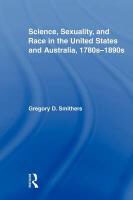Read more
This book combines transnational history with the comparative analysis of racial formation and reproductive sexuality in the settler colonial spaces of the United States and British Australia. Specifically, the book places "whiteness," and the changing definition of what it meant to be white in nineteenth-century America and Australia, at the center of our historical understanding of racial and sexual identities. In both the United States and Australia, "whiteness" was defined in opposition to the imagined cultural and biological inferiority of the "Indian," "Negro," and "Aboriginal savage." Moreover, Euro-Americans and Euro-Australians shared a common belief that "whiteness" was synonymous with the extension of settler colonial civilization. Despite this, two very different understandings of "whiteness" emerged in the nineteenth century. The book therefore asks why these different racial understandings of "whiteness" -- and the quest to create culturally and racially homogeneous settler civilizations -- developed in the United States and Australia.
List of contents
Introduction Part I 1. On the Importance of Good Breeding 2. Debating Race and the Meaning of Whiteness 3. Eliminating the 'dubious hyphen between savagery and civilization' Part II 4. Missionaries, Settlers, Cherokees & African-Americans, 1780s-1850s 5. Missionaries, Settlers, & Australian Aborigines, 1780s-1850 6. The Evolution of an American Race, 1860s-1890s 7. The Evolution of White Australia, 1860s-1890s. Conclusion
About the author
Gregory D. Smithers is a Lecturer in American History at the University of Aberdeen in Scotland. His works include: "Black gentleman as good as white": Comparing the Origins and Development of African-American and Australian Aboriginal Political Protest," Journal of African American History (Fall, 2008); "The 'pursuits of the civilized man': Race and the Meaning of Civilization in the United States and Australia, 1790s-1850s," Journal of World History (Fall 2008).

